Alternating Wetting and Moderate Drying Irrigation Promotes Phosphorus Uptake and Transport in Rice
Abstract
1. Introduction
2. Materials and Methods
2.1. Experimental Site and Plant Cultivation
2.2. Experimental Design
2.3. Sampling and Measurements
2.3.1. Leaf Area and Biomass
2.3.2. Phosphorus Accumulation
2.3.3. Leaf Water Potential
2.3.4. Leaf Photosynthetic Rate
2.3.5. Root Oxidation Activity and Root Morphology
2.3.6. Activities of Enzymes Involved in Phosphorus Uptake and Transport
2.4. Final Harvest
2.5. Statistical Analysis
3. Results
3.1. Grain Yield and PUE
3.2. Soil Water Potential and Leaf Water Potential
3.3. Leaf Photosynthetic Rate and Leaf Area Index
3.4. Biomass and Root–Shoot Ratio
3.5. Root Oxidization Activity and Root Morphology
3.6. P Accumulation
3.7. Activities of the Key Enzymes in P Uptake and Transport
4. Discussion
5. Conclusions
Author Contributions
Funding
Data Availability Statement
Acknowledgments
Conflicts of Interest
References
- Sen, S.; Chakraborty, R.; Kalita, P. Rice-not just a staple food: A comprehensive review on its phytochemicals and therapeutic potential. Trends Food Sci. Technol. 2020, 97, 265–285. [Google Scholar] [CrossRef]
- Prathap, V.; Kumar, S.; Tyagi, A. Comparative proteome analysis of phosphorus-responsive genotypes reveals the proteins differentially expressed under phosphorous starvation stress in rice. Int. J. Biol. Macromol. 2023, 234, 123760. [Google Scholar] [CrossRef] [PubMed]
- Secco, D.; Wang, C.; Shou, H.; Schultz, M.D.; Chiarenza, S.; Nussaume, L.; Ecker, J.R.; Whelan, J.; Lister, R. Stress induced gene expression drives transient DNA methylation changes at adjacent repetitive elements. Elife 2015, 4, 09434. [Google Scholar] [CrossRef]
- Luan, M.; Tang, R.J.; Tang, Y.; Tian, W.; Hou, C.; Zhao, F.; Lan, W.; Luan, S. Transport and homeostasis of potassium and phosphate: Limiting factors for sustainable crop production. J. Exp. Bot. 2017, 68, 3091–3105. [Google Scholar] [CrossRef] [PubMed]
- Kumar, S.; Pallavi Chugh, C.; Seem, K.; Kumar, S.; Vinod, K.K.; Mohapatra, T. Characterization of contrasting rice (Oryza sativa L.) genotypes reveals the Pi-efficient schema for phosphate starvation tolerance. BMC Plant Biol. 2021, 21, 282. [Google Scholar] [CrossRef]
- Dissanayaka, D.; Ghahremani, M.; Siebers, M.; Wasaki, J.; Plaxton, W.C. Recent insights into the metabolic adaptations of phosphorus-deprived plants. J. Exp. Bot. 2021, 72, 199–223. [Google Scholar] [CrossRef]
- Chowdhury, R.B.; Moore, G.A.; Weatherley, A.J.; Arora, M. Key sustainability challenges for the global phosphorus resource, their implications for global food security, and options for mitigation. J. Clean. Prod. 2017, 140, 945–963. [Google Scholar] [CrossRef]
- Prathap, V.; Kumar, S.; Meena, N.L.; Maheshwari, C.; Dalal, M.; Tyagi, A. Phosphorus starvation tolerance in rice through combined physiological, biochemical, and proteome analyses. Rice Sci. 2023, 30, 613–631. [Google Scholar] [CrossRef]
- Ham, B.-K.; Chen, J.; Yan, Y.; Lucas, W.J. Insights into Plant Phosphate Sensing and Signaling. Curr. Opin. Biotechnol. 2018, 49, 1–9. [Google Scholar] [CrossRef]
- Rinasoa, S.; Rakotoson, T.; Rabeharisoa, L.; Tsujimoto, Y.; Nishigaki, T. Farmyard manure application increases lowland rice yield in phosphorus-deficient soils, but not in soils with high pH and phosphorus-fixing capacity. Field Crops Res. 2023, 296, 108906. [Google Scholar] [CrossRef]
- Xia, Y.; Zhang, M.; Tsang, D.C.W.; Geng, N.; Lu, D.; Zhu, L.; Igalavithana, A.D.; Dissanayake, P.D.; Rinklebe, J.; Yang, X.; et al. Recent advances in control technologies for non-point source pollution with nitrogen and phosphorous from agricultural runoff: Current practices and future prospects. Appl. Biol. Chem. 2020, 63, 8. [Google Scholar] [CrossRef]
- Liu, D.; Zhang, C.; Yan, N.; Yan, Y.; Duan, H. Eutrophication exacerbated organic pollution in lakes across China during the 1980s–2010s. Water Res. 2015, 268, 122782. [Google Scholar] [CrossRef] [PubMed]
- Lee, B.; Kim, M.; Geem, K.R.; Sung, J. Improving nutrient use efficiency of rice under alternative wetting and drying irrigation combined with slow-release nitrogen fertilization. Plants 2025, 14, 1530. [Google Scholar] [CrossRef]
- Adem, G.D.; Ueda, Y.; Hayes, P.E.; Wissuwa, M. Genetic and physiological traits for internal phosphorus utilization efficiency in rice. PLoS ONE 2020, 15, e0241842. [Google Scholar] [CrossRef] [PubMed]
- Negi, S.; Cheng, Y.C.; Wang, S.L.; Ho, S.T.; Pan, S.Y. Harvesting rice straw management synergies for lifecycle environmental and economic sustainability. Sci. Total Environ. 2025, 969, 178931. [Google Scholar] [CrossRef]
- Atwill, R.L.; Spencer, G.D.; Bond, J.A.; Walker, T.W.; Phillips, J.M.; Mills, B.E.; Krutz, L.J. Establishment of thresholds for alternate wetting and drying irrigation management in rice. Agron. J. 2023, 115, 1735–1745. [Google Scholar] [CrossRef]
- Hamoud, Y.A.; Shaghaleh, H.; Wang, R.; Gouertoumbo, W.F.; Hamad, A.A.A.; Sheteiwy, M.S.; Wang, Z.; Guo, X. Wheat straw burial improves physiological traits, yield and grain quality of rice by regulating antioxidant system and nitrogen assimilation enzymes under alternate wetting and drying irrigation. Rice Sci. 2022, 29, 473–488. [Google Scholar] [CrossRef]
- Hong Trang, V.; Nelson, K.M.; Samsuzzaman, S.; Rahman, S.M.; Rashid, M.; Salahuddin, A.; Sander, B.O. Institutional analysis for scaling alternate wetting and drying for low-emissions rice production: Evidence from bangladesh. Clim. Dev. 2022, 15, 10–19. [Google Scholar] [CrossRef]
- Natarajan, S.K.; Gowsalya, R.; Kathirvelan, P.; Venkatachalam, S.R.; Jaya Prabhavathi, S.; Elankavi, S.; Bhuvaneswari, J.; Sampathkumar, T.; Satheesh Kumar, N.; Pazhalanivelan, S. Impact of alternate wetting and drying irrigation (AWDI) on water saving and yield of transplanted rice. J. Exp. Agric. Int. 2025, 47, 451–460. [Google Scholar]
- Gharsallah, O.; Rienzner, M.; Mayer, A.; Tkachenko, D.; Corsi, S.; Vuciterna, R.; Romani, M.; Ricciardelli, A.; Cadei, E.; Trevisan, M.; et al. Economic, environmental, and social sustainability of alternate wetting and drying irrigation for rice in northern Italy. Front. Water 2023, 5, 1213047. [Google Scholar] [CrossRef]
- Phoeurn, C.A.; Degre, A.; Oeurng, C.; Ket, P. Evaluating the impact of climate change on yield and water use efficiency of different dry-season rice varieties cultivated under conventional and alternate wetting and drying conditions. Environ. Monit. Assess. 2024, 196, 1190. [Google Scholar] [CrossRef] [PubMed]
- Johnson, J.M.; Becker, M.; Dossou-Yovo, E.R.; Saito, K. Enhancing rice yields, water productivity, and profitability through alternate wetting and drying technology in farmers’ fields in the dry climatic zones of West Africa. Agric. Water Manag. 2024, 304, 109096. [Google Scholar] [CrossRef]
- Hoang, T.N.; Minamikawa, K.; Tokida, T.; Wagai, R.; Tran, T.X.P.; Tran, T.H.D.; Tran, D.H. Higher rice grain yield and lower methane emission achieved by alternate wetting and drying in central Vietnam. Eur. J. Agron. 2023, 151, 126992. [Google Scholar] [CrossRef]
- Song, T.; Xu, F.; Yuan, W.; Chen, M.; Hu, Q.; Tian, Y.; Zhang, J.; Xu, W. Combining alternate wetting and drying irrigation with reduced phosphorus fertilizer application reduces water use and promotes phosphorus use efficiency without yield loss in rice plants. Agric. Water Manag. 2019, 223, 105686. [Google Scholar] [CrossRef]
- Pramono, A.; Adriany, T.A.; Al Viandari, N.; Susilawati, H.L.; Wihardjaka, A.; Sutriadi, M.T.; Yusuf, W.A.; Ariani, M.; Wagai, R.; Tokida, T.; et al. Higher rice yield and lower greenhouse gas emissions with cattle manure amendment is achieved by alternate wetting and drying. Soil Sci. Plant Nutr. 2024, 70, 129–138. [Google Scholar] [CrossRef]
- Guo, M.X.; Zheng, L.; Zhao, X.S. Iron uptake, translocation and regulation in rice. Hereditas 2017, 39, 388–395. (In Chinese) [Google Scholar]
- Li, Y.; Zeng, H.; Xu, F.; Yan, F.; Xu, W. H+-ATPases in plant growth and stress responses. Annu. Rev. Plant Biol. 2022, 73, 495–521. [Google Scholar] [CrossRef]
- Shi, W.; Cao, T.; Yuan, Z.; Wang, Y.; Ying, Y. Phosphorus deficiency promotes root morphological and biochemical changes to enhance phosphorus uptake in phyllostachys edulis seedlings. Plant Soil 2025, in press. [Google Scholar] [CrossRef]
- Zhang, H.; Chen, M.; Xu, C.; Liu, R.; Tang, W.; Chen, K.; Zhou, Y.; Xu, Z.; Chen, J.; Ma, Y.; et al. H+-Pyrophosphatases enhance low nitrogen stress tolerance in transgenic arabidopsis and wheat by Interacting with a receptor-like protein kinase. Front. Plant Sci. 2023, 14, 1096091. [Google Scholar] [CrossRef]
- Yang, J.C.; Zhang, J.H.; Ye, Y.X.; Wang, Z.Q.; Zhu, Q.S.; Liu, L.J. Involvement of abscisic acid and ethylene in the responses of rice grains to water stress during filling. Plant Cell Environ. 2004, 27, 1055–1064. [Google Scholar] [CrossRef]
- Zhang, W.; Yu, J.; Xu, Y.; Wang, Z.; Liu, L.; Zhang, H.; Gu, J.; Zhang, J.; Yang, J. Alternate wetting and drying irrigation combined with the proportion of polymer-coated urea and conventional urea rates increases grain yield, water and nitrogen use efficiencies in rice. Field Crops Res. 2021, 268, 108165. [Google Scholar] [CrossRef]
- Gu, H.; Wang, X.; Zhang, M.; Jing, W.; Wu, H.; Xiao, Z.; Zhang, W.; Gu, J.; Liu, L.; Wang, Z.; et al. The response of roots and the rhizosphere environment to integrative cultivation practices in paddy rice. J. Integr. Agric. 2024, 23, 1879–1896. [Google Scholar] [CrossRef]
- Yoshida, S.; Coronel, V. Nitrogen nutrition, leaf resistance, and leaf photosynthetic rate of the rice plant. Soil Sci. Plant Nutr. 1976, 22, 207–211. [Google Scholar] [CrossRef]
- Nazari, B.; Liaghat, A.; Akbari, M.R.; Keshavarz, M. Irrigation water management in Iran: Implications for water use efficiency improvement. Agric. Water Manag. 2018, 208, 7–18. [Google Scholar] [CrossRef]
- Pan, J.; Liu, Y.; Zhong, X.; Lampayan, R.M.; Singleton, G.R.; Huang, N.; Liang, K.; Peng, B.; Tian, K. Grain yield, water productivity and nitrogen use efficiency of rice under different water management and fertilizer-N inputs in South China. Agric. Water Manag. 2017, 184, 191–200. [Google Scholar] [CrossRef]
- Singh, A.; Dass, A.; Dhar, S.; Singh, C.V.; Sudhishri, S.; Singh, T.; Rajanna, G.A.; Pande, P. Water management and planting methods influence growth, spikelet sterility and nutrient acquisition in aerobic rice. Int. J. Curr. Microbiol. Appl. Sci. 2019, 8, 554–565. [Google Scholar] [CrossRef]
- Shehzad, F.; Ali, Q.; Ali, S.; Al-Misned, F.A.; Maqbool, S. Fertigation with Zn-Lysine confers better photosynthetic efficiency and yield in water stressed maize: Water relations, antioxidative defense mechanism and nutrient acquisition. Plants 2022, 11, 404. [Google Scholar] [CrossRef] [PubMed]
- Yang, J.; Zhang, J. Approach and mechanism in enhancing the remobilization of assimilates and grain-filling in rice and wheat. Chin. Sci. Bull. 2018, 63, 2932–2943. (In Chinese) [Google Scholar] [CrossRef]
- Xu, G.; Lu, D.; Wang, H.; Li, Y. Morphological and physiological traits of rice roots and their relationships to yield and nitrogen utilization as influenced by irrigation regime and nitrogen rate. Agric. Water Manag. 2018, 203, 385–394. [Google Scholar] [CrossRef]
- Robinson, W.D.; Park, J.; Tran, H.T.; Del Vecchio, H.A.; Ying, S.; Zins, J.L.; Patel, K.; McKnight, T.D.; Plaxton, W.C. The secreted purple acid phosphatase isozymes Atpap12 and Atpap26 play a pivotal role in extracellular phosphate-scavenging by arabidopsis thaliana. J. Exp. Bot. 2012, 63, 6531–6542. [Google Scholar] [CrossRef]
- Kumar, S.; Agrawal, A.; Seem, K.; Kumar, S.; Vinod, K.K.; Mohapatra, T. Transcriptome analysis of a near-Isogenic line and its recurrent parent reveals the role of Pup1 Qtl in phosphorus deficiency tolerance of rice at tillering stage. Plant Mol. Biol. 2022, 109, 29–50. [Google Scholar] [CrossRef] [PubMed]
- Wang, L.; Li, Z.; Qian, W.; Guo, W.; Gao, X.; Huang, L.; Wang, H.; Zhu, H.; Wu, J.W.; Wang, D.; et al. The arabidopsis purple acid phosphatase Atpap10 is predominantly associated with the root surface and plays an important role in plant tolerance to phosphate limitation. Plant Physiol. 2011, 157, 1283–1289. [Google Scholar] [CrossRef] [PubMed]
- Wang, J.; Wei, Z.; Zhao, Y.; Xia, X.; Cui, J.; Li, S. The strategies for improving phosphorus-use efficiency in plant cell. Soil Sci. Plant Nutr. 2024, 71, 53–60. [Google Scholar] [CrossRef]
- Pavankumar, T.L. Rnase R Vs. Pnpase: Selecting the best-suited exoribonuclease for environmental adaptation. Extremophiles 2024, 28, 35. [Google Scholar] [CrossRef] [PubMed]
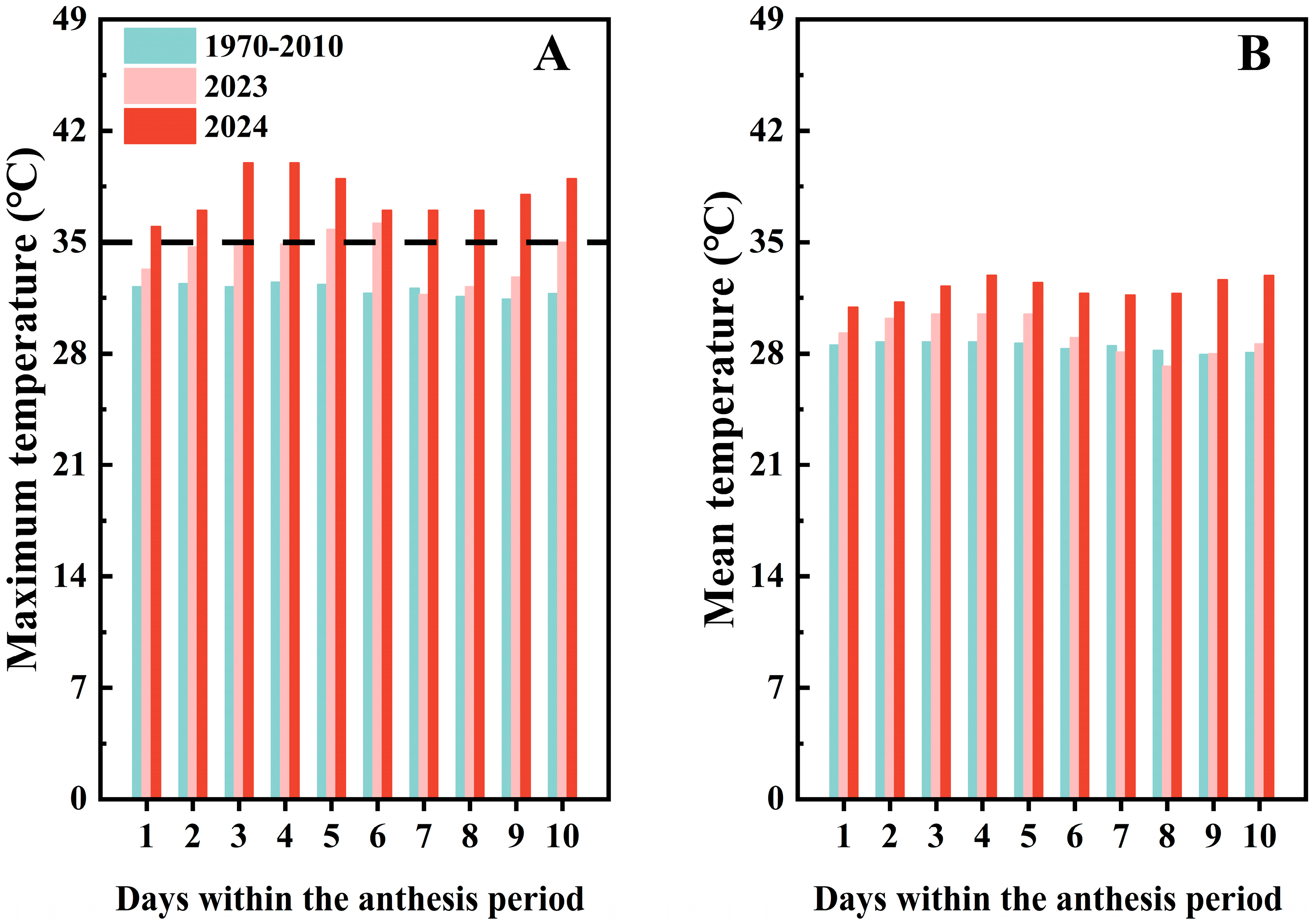

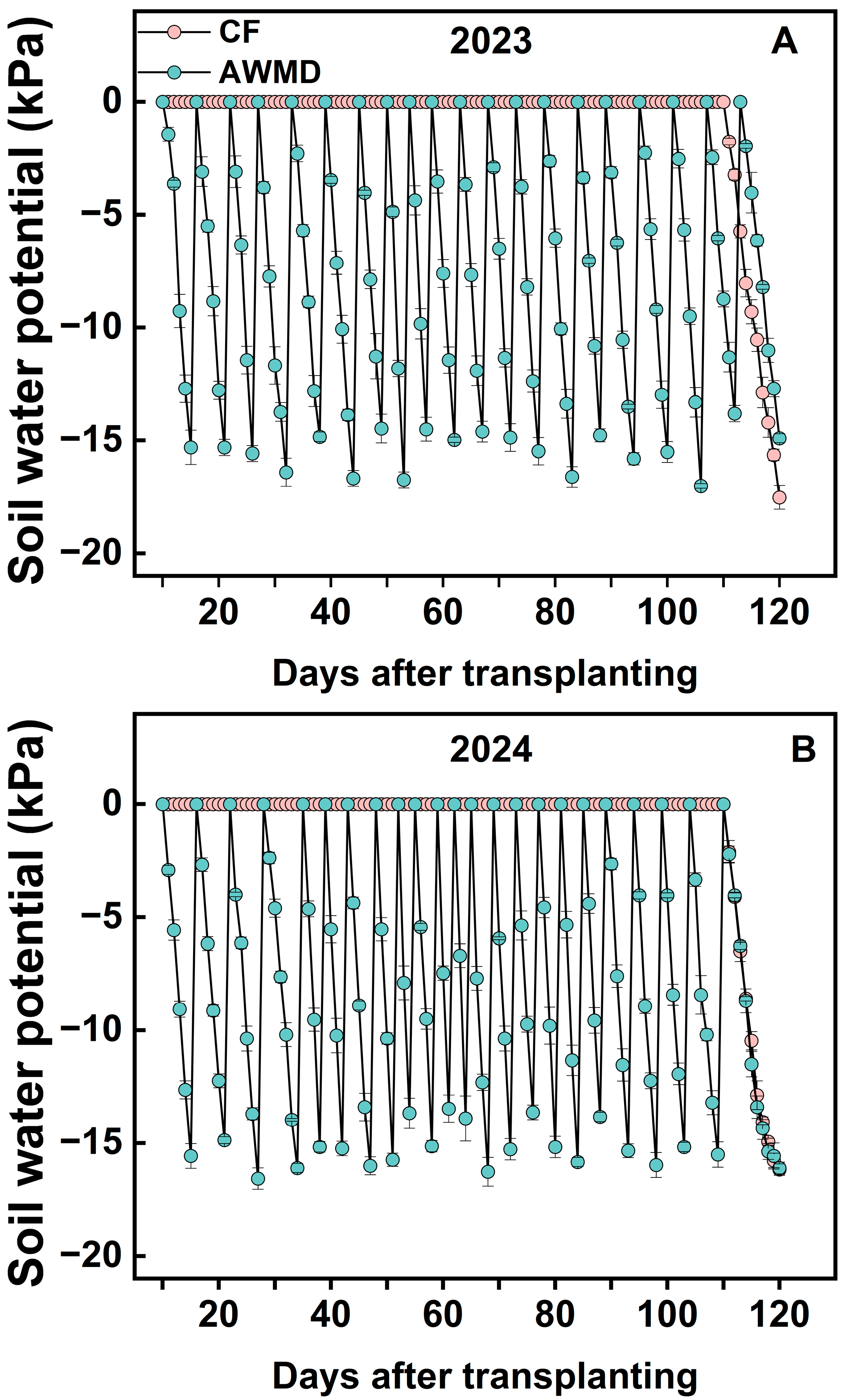
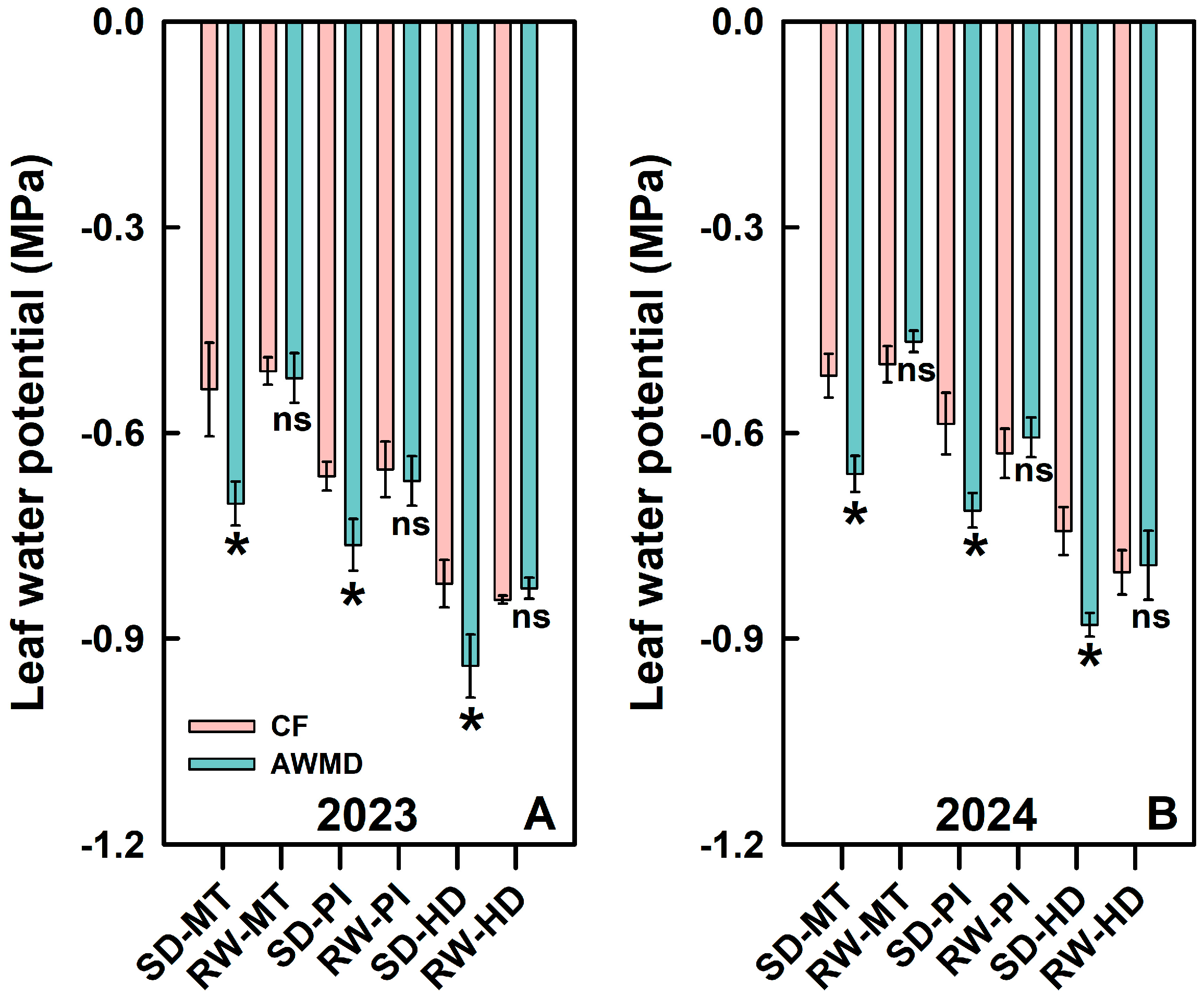
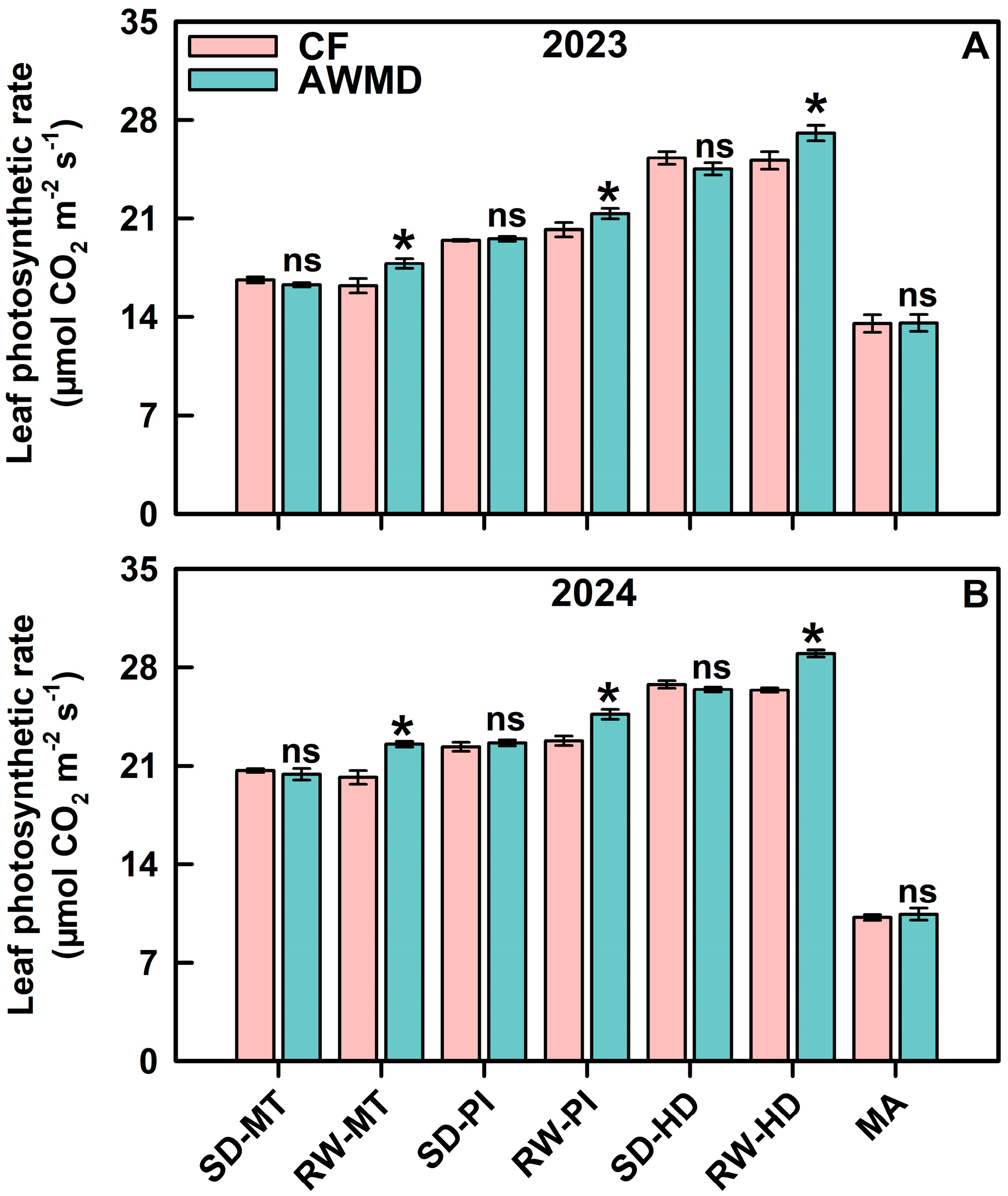
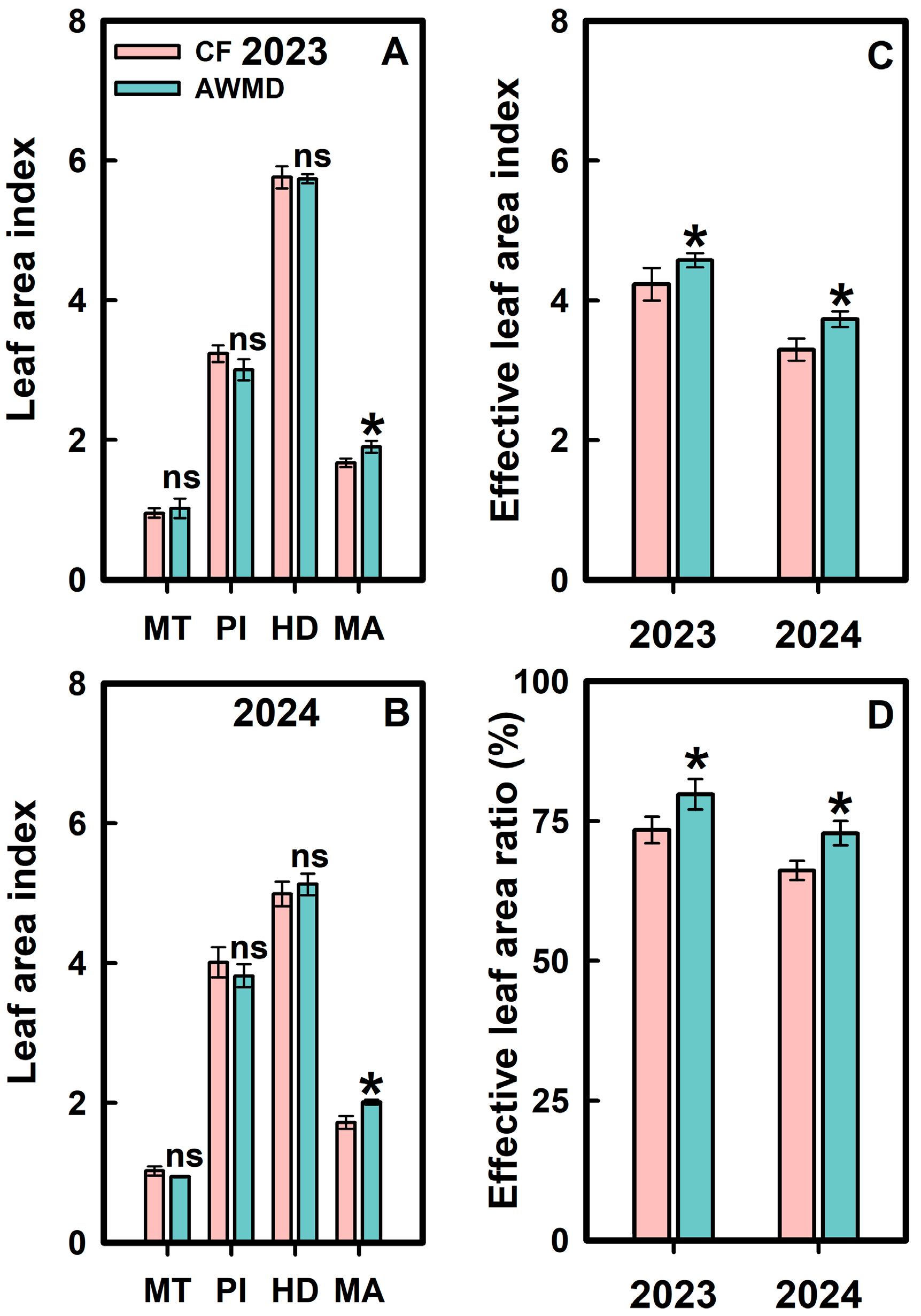
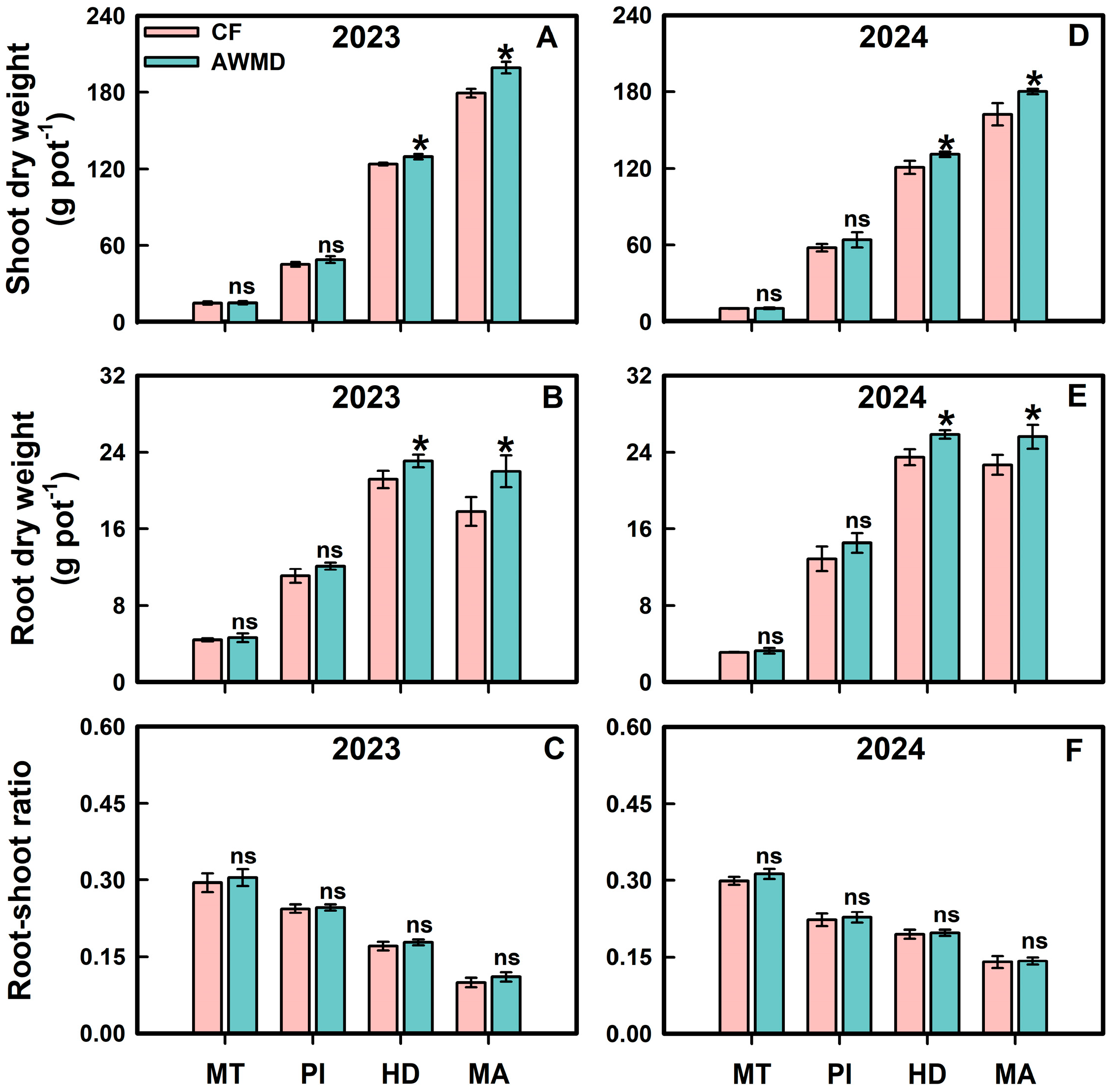
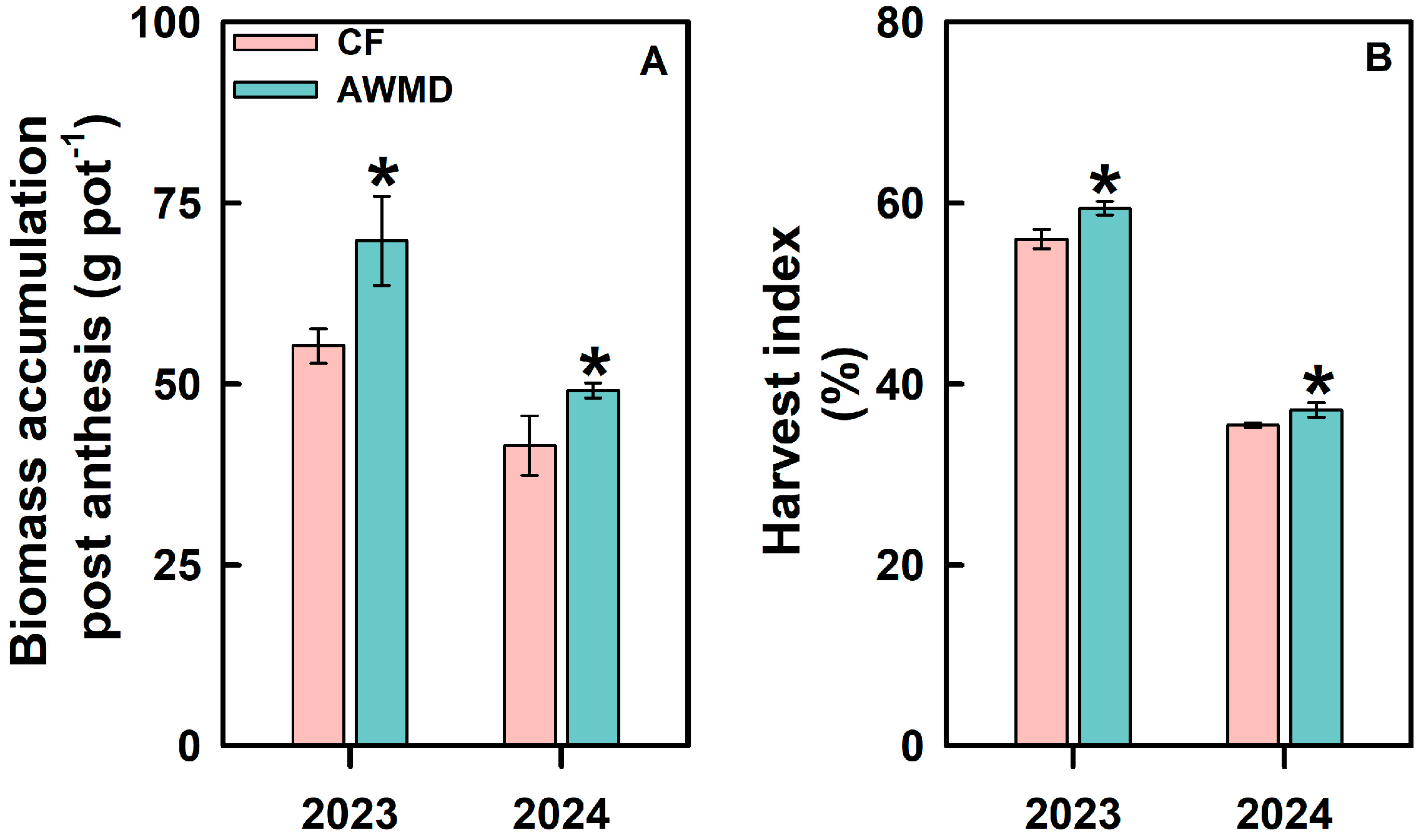
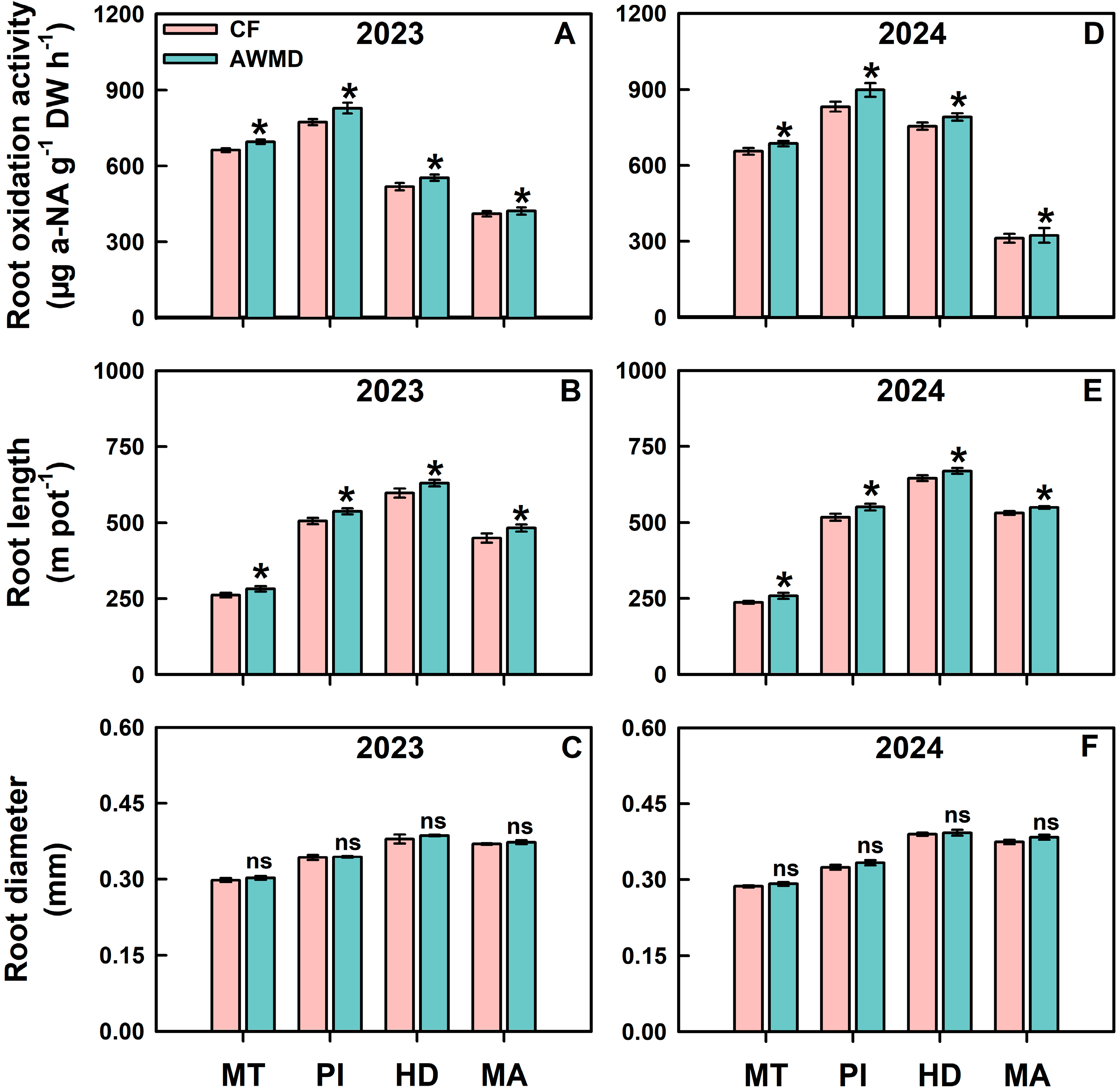

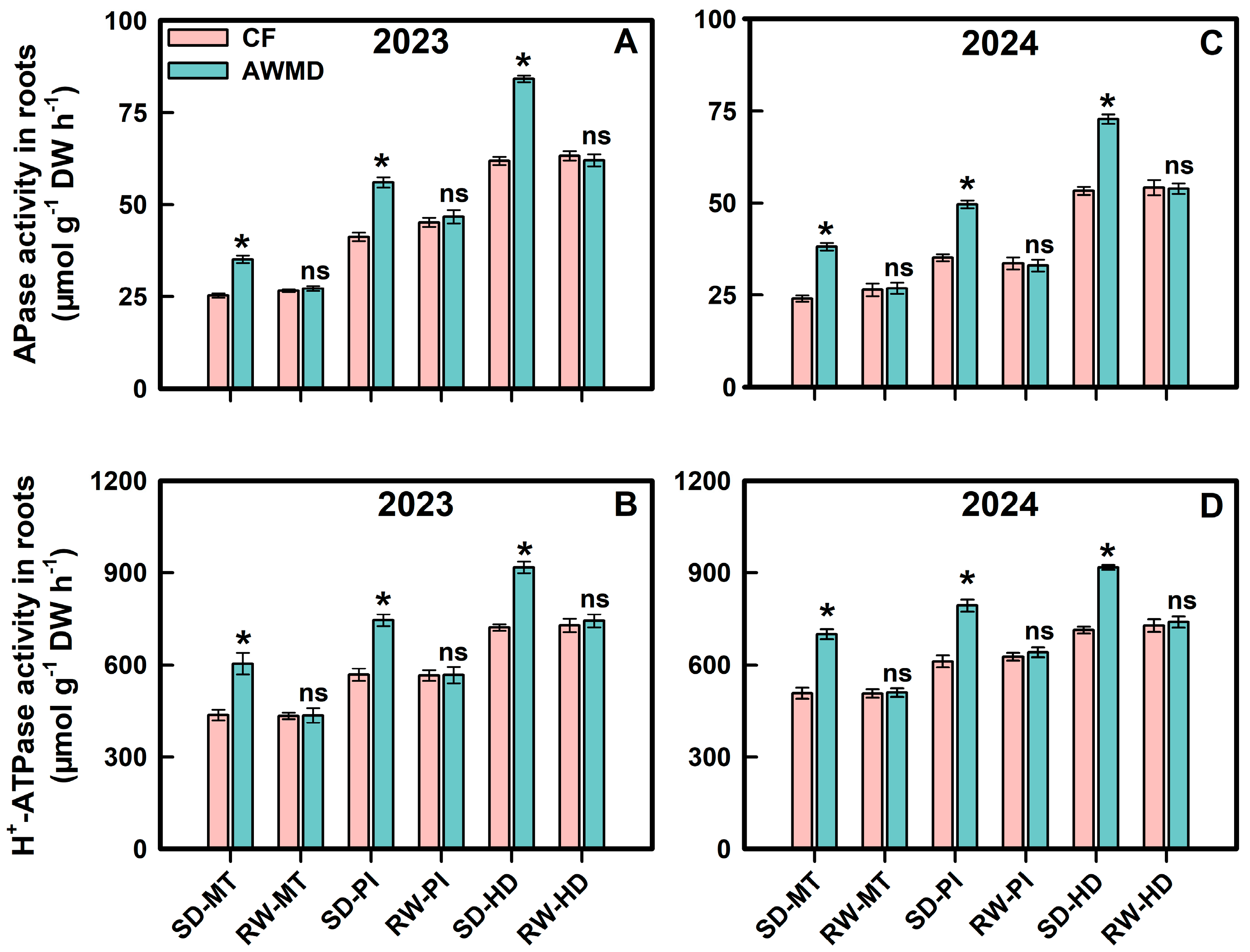
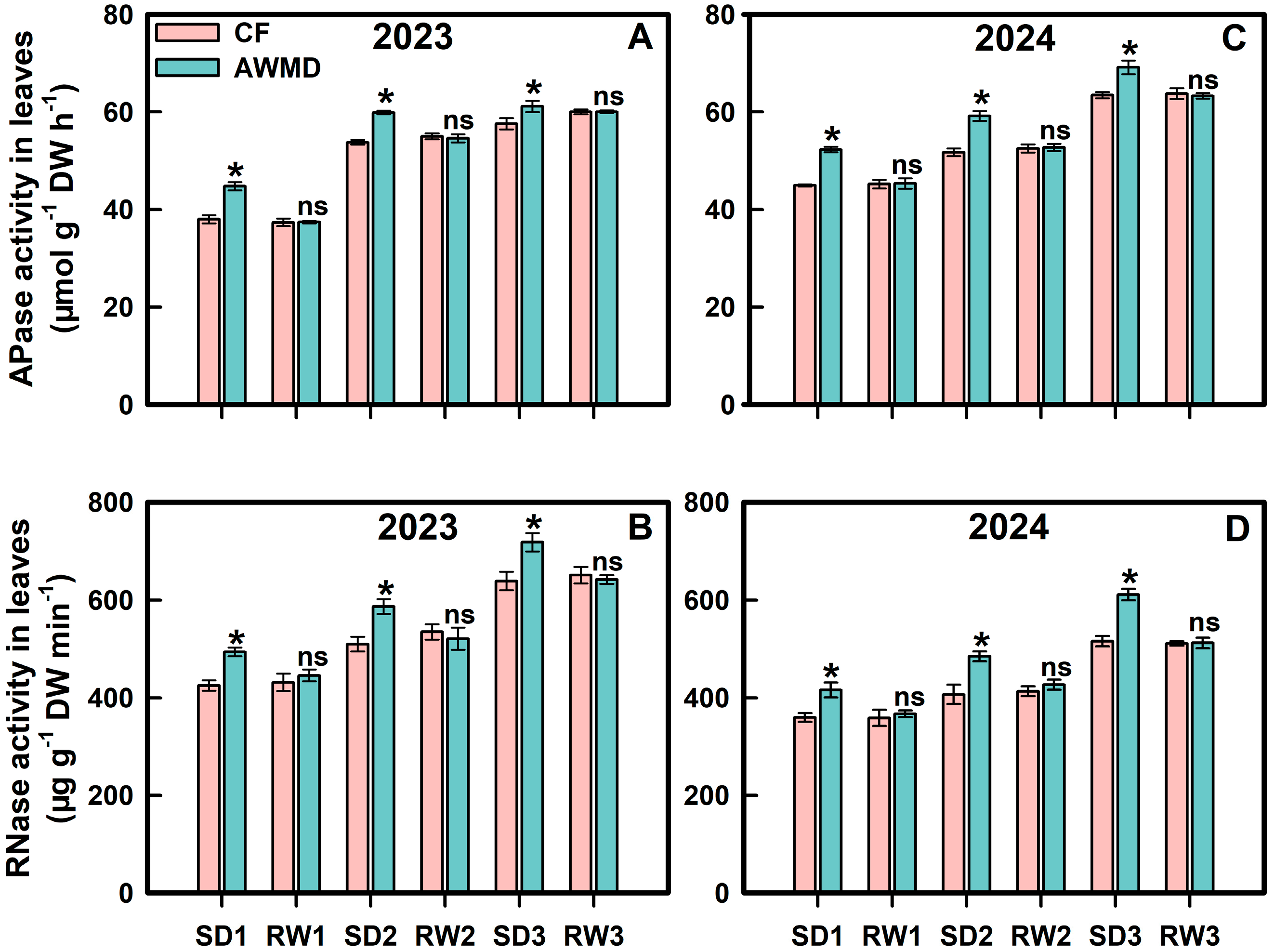

| Year | Irrigation Regime | Panicles per Pot | Spikelets per Panicle | Fertization Rate (%) | Fully Filled Grains (%) | 1000-Grain Weight (g) | Grain Yield (g pot−1) |
|---|---|---|---|---|---|---|---|
| 2023 | CF | 18.6 | 159 | 88.4 | 84.8 | 28.1 | 65.9 |
| AWMD | 17.9 ns | 165 * | 91.4 ns | 88.5 * | 28.3 * | 73.2 * | |
| 2024 | CF | 22.0 | 148 | 61.4 | 40.4 | 27.3 | 27.7 |
| AWMD | 21.1 ns | 156 * | 68.3 * | 48.3 * | 27.8 * | 30.1 * |
Disclaimer/Publisher’s Note: The statements, opinions and data contained in all publications are solely those of the individual author(s) and contributor(s) and not of MDPI and/or the editor(s). MDPI and/or the editor(s) disclaim responsibility for any injury to people or property resulting from any ideas, methods, instructions or products referred to in the content. |
© 2025 by the authors. Licensee MDPI, Basel, Switzerland. This article is an open access article distributed under the terms and conditions of the Creative Commons Attribution (CC BY) license (https://creativecommons.org/licenses/by/4.0/).
Share and Cite
Fu, J.; Liu, Y.; Zhang, Y.; Zhu, K.; Gu, J.; Wang, Z.; Zhang, W.; Yang, J. Alternating Wetting and Moderate Drying Irrigation Promotes Phosphorus Uptake and Transport in Rice. Agronomy 2025, 15, 1488. https://doi.org/10.3390/agronomy15061488
Fu J, Liu Y, Zhang Y, Zhu K, Gu J, Wang Z, Zhang W, Yang J. Alternating Wetting and Moderate Drying Irrigation Promotes Phosphorus Uptake and Transport in Rice. Agronomy. 2025; 15(6):1488. https://doi.org/10.3390/agronomy15061488
Chicago/Turabian StyleFu, Jiangyao, Ying Liu, Yajun Zhang, Kuanyu Zhu, Junfei Gu, Zhiqin Wang, Weiyang Zhang, and Jianchang Yang. 2025. "Alternating Wetting and Moderate Drying Irrigation Promotes Phosphorus Uptake and Transport in Rice" Agronomy 15, no. 6: 1488. https://doi.org/10.3390/agronomy15061488
APA StyleFu, J., Liu, Y., Zhang, Y., Zhu, K., Gu, J., Wang, Z., Zhang, W., & Yang, J. (2025). Alternating Wetting and Moderate Drying Irrigation Promotes Phosphorus Uptake and Transport in Rice. Agronomy, 15(6), 1488. https://doi.org/10.3390/agronomy15061488






